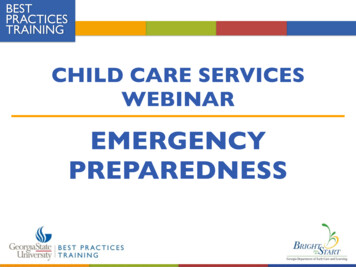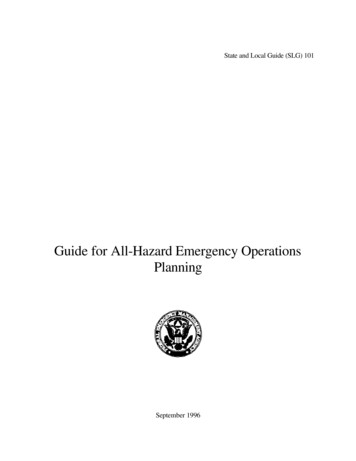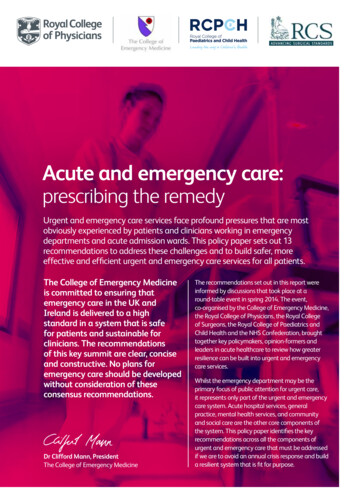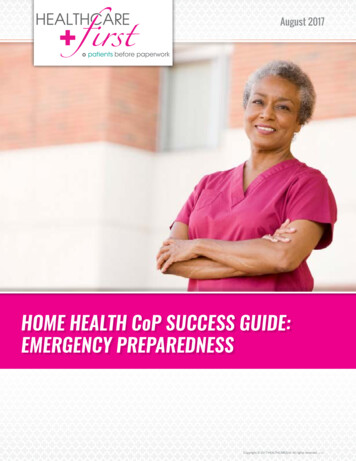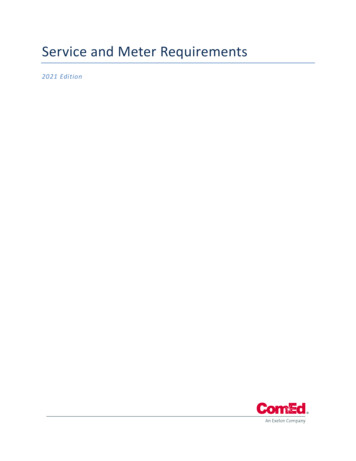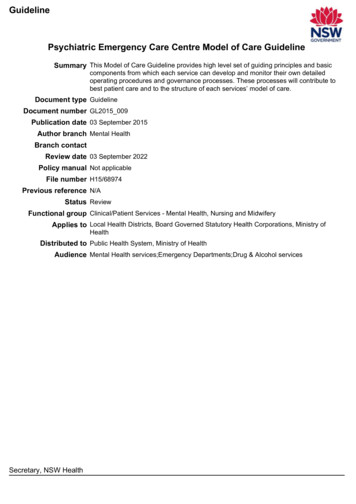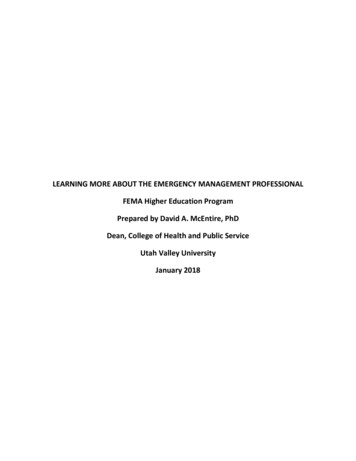
Transcription
LEARNING MORE ABOUT THE EMERGENCY MANAGEMENT PROFESSIONALFEMA Higher Education ProgramPrepared by David A. McEntire, PhDDean, College of Health and Public ServiceUtah Valley UniversityJanuary 2018
INTRODUCTIONWant to learn more about the emergency management professional and work in thisimportant area?Congratulations! You are about to enter one of the most important, dynamic andrewarding careers in the United Stated and around the world!The emergency management profession is vital since disasters are increasing infrequency and intensity. In addition, the profession is ever-changing since hazards andvulnerabilities are changing over time and because the methods to deal with them areimproving as well. And, the profession is satisfying since it provides countless benefit towardthe well-being of society.Perhaps you have questions about this particular career and how to become aprofessional in emergency management. This is understandable and perfectly normal.Emergency management is a relatively new and complex profession. Therefore, most peoplestruggle to comprehend the vast array of options for employment. And, even fewer peopleunderstand professional roles within the unique but complex nature of emergencymanagement. For these reasons, it is important to finds ways to facilitate and improve entryinto this profession and help individuals launch and advance their careers.The Department of Labor periodically generates an Occupational Outlook Handbook tohelp answer general inquiries about employment. This document describes various aspects ofmany careers, including emergency management (DOL 2016-17). Quick Facts about a veryspecific position in emergency management – Emergency Management Directors – are shownin the chart below.
DOL Emergency Management Director Quick Facts2016 Median PayTypical Entry-Level EducationWork Experience in a RelatedOccupationOn-the-job TrainingNumber of Jobs, 2014Job Outlook, 2014-24Employment Change, 2014-24 70,500 per year ( 33.89 per hour)Bachelor’s Degree5 years or moreNone10,5006% (as fast as average)700This information provides a useful glimpse into one very specific career in emergencymanagement. But, it does not tell the whole story about this profession. There are many otherwonderful career options in emergency management. And, because the chart is limited, thedetails are incomplete and perhaps even unintentionally misleading. For instance, there iscertainly on-the-job training for those working in emergency management and there are morepeople employed in this area than Emergency Managers alone.For this reason, it is important that you undertake a more thorough examination ofemergency management to see if this type of employment is the right choice for you.In the following document, you will find answers to significant questions: What is emergency management?Who works in emergency management and what do they do?What is the job of emergency management like?What career options exist?What do those employed in emergency management make?How do I become an emergency management professional?How can I advance my career in emergency management?The goal of this document is to help you find answers to these significant inquiries. In sodoing, you will be better prepared to enter and contribute to the vital emergency managementprofession.
MODULE 1: WHAT IS EMERGENCY MANAGEMENT?1.1 Emergencies and DisastersEach day, there are countless emergencies and disasters in the United States andelsewhere around the world. On occasion, there are more significant catastrophes andcalamities that have an even greater impact on individuals, organizations and societies. Theseevents may result from natural, technological or anthropogenic hazards such as earthquakes,tornadoes, hurricanes, wildfires, industrial explosions, chemical releases, transportationaccidents or terrorist attacks. When these hazards interact with vulnerable people and fragileinfrastructure, they result in injury, death, damage and disruption.Important TerminologyEmergencies – small scale disasters with limited impacts.Disasters – deadly, destructive and disruptive events that occur when a hazard interacts with humanvulnerability.Catastrophes/Calamities – large scale disasters with extensive impacts.Natural hazards – triggering agents produced by earth systems, such as the atmosphere, geological,hydrological, seismic, etc.Technological hazards – triggering agents resulting from technology, such as petro-chemical facilities,power plants, computer networks, etc.Anthropogenic hazards – triggering agents generated by people, such as a transportation accident,mass shooting, terrorist bombing, etc.Vulnerability
1.2 Emergency ManagementIn order to be ready for such devastating events, the profession of emergencymanagement is desperately needed. Emergency Management can be defined as an effort toplan how to deal with disasters in the most effective manner. Nevertheless, there is far more toemergency management than meets the eye.There is no single, agreed-upon conceptualization of emergency management. Manyscholars and government agencies have developed their own definition for the term. On theacademic side, scholars have defined emergency management from a disciplinary perspective: “Emergency management is the discipline dealing with risk and risk avoidance.”(Haddow and Bullock 2003, 1).Emergency management “is the study of how humans and their institutions deal withhazards, vulnerabilities and the events that result from their interaction” (Jensen, 2013).Emergency management has also been defined from a professional orientation or interms of practical application. The following are common examples of these types ofdefinitions: “In simplest terms, emergency management is the management of risk so that societiescan live with environmental and technical hazards and deal with the disasters that theycause” (Waugh 2000, 3)“Emergency management is the . . . profession of applying science, technology,planning, and management to deal with extreme events that can injure or kill largenumbers of people, do extensive damage to property, and disrupt community life”(Drabek and Hoetmer 1991, xvii).Emergency management is “An ongoing process to prevent, mitigate, prepare for,respond to, maintain continuity during, and to recover from an incident that threatenslife, property, operations, or the environment” (NFPA 1600).Probably the most well-known definition of emergency management comes from theFEMA Emergency Management Focus Group. This collection of scholars and professionalsdefined emergency management as “the managerial function charged with creating the
framework within which communities reduce vulnerability to hazards and cope with disasters”(Blanchard et al., 2007, p. 4). This suggests that the profession is in charge of administrativedecisions and actions that anticipate hazards, reduce vulnerability and address the impacts ofdisasters. Emergency management is therefore related to many other professions, careers andareas of employment including risk management, business continuity planning, land-useplanning, flood plain management, emergency services, homeland security, humanitarianassistance, etc.1.3 Goals of Emergency ManagementThe goal of the emergency management profession is summarized in the visionstatement provided by the Emergency Management Focus Group. This group asserted that“emergency management seeks to promote safer, less vulnerable communities with thecapacity to cope with hazards and disasters.” In other words, emergency managementendeavors to protect live, property and the environment.The objectives described above require fulfillment of the mission of emergencymanagement. According to the Emergency Management Focus Group, emergency management“protects communities by coordinating and integrating all activities necessary to build, sustain,and improve the capability to mitigate against, prepare for, respond to, and recovery fromthreatened or actual natural disasters, acts of terrorism, or other man-made disasters.”1.4 Phases of Emergency ManagementThis brings up what is commonly known as the four phases of emergency management:1.Mitigation refers to the minimization of risk and actions to reduce occurrence andloss. Note: In homeland security parlance, this equates to prevention andprotection.oPrevention includes efforts stop terrorist attacks before they occur.
2.3.4.oProtection incorporates actions to minimize damage.Preparedness implies efforts to increase readiness for disaster.Response suggests activities in the immediate aftermath of a disaster to save livesand spare property.Recovery insinuates efforts to return the affected community to pre-disaster, orpreferably, improved conditions.1.5 Functions in Emergency ManagementAlthough the four phases are useful concepts to simplify the emergency managementprofession, there are countless functions that have to be performed before, during and afteremergencies, disasters and catastrophes. For instance: Land-use planning is promoted to limit development in hazardous prone areas.Structural mitigation is advocated to strengthen structures and infrastructure.Planning is required understand hazards and vulnerability, and anticipate what actionswill need to be performed when disaster strikes.Training is necessary to increase capabilities to react to disasters successfully.Exercising is beneficial to test plans and reinforce what is taught through training.Hazard detection and warning are imperative if advanced notice of hazards anddisasters are to be given.Evacuation is essential if people are to be moved to safer locations.Sheltering is indispensable when homes and apartment have been damaged anddestroyed.Search and rescue is crucial when people have been trapped under collapsed buildingsor swept away by high water.Emergency medical care and triage is vital when injuries may be life-threatening andthe needs of victims have to be assessed to determine priorities.Mass fatality management is critical when the number of dead outstrip existingresources.Crisis counseling is helpful since disasters could produce major emotional challenges.Media relations are beneficial to keep victims and responding organizations informed.Donations and volunteer management is important to harness the good will ofsurvivors and non-impacted communities.Damage assessment is fundamental to determine what locations merit attention first.Disaster declarations are key to sharing needs with outside agencies.Debris removal is mandatory when disaster produce significant damages and rubble.Disaster assistance is valuable for those who have lost housing, employment andpossessions.
1.6 Principles of Emergency ManagementFortunately, there are important principles to help guide the emergency managementprofession in the completion of these various duties. The Emergency Management Focus Groupidentified eight principles for emergency management. Specifically, emergency Managementmust be:1. Comprehensive. Emergency managers consider and take into account all hazards, allphases, all stakeholders and all impacts relevant to disasters.2. Progressive. Emergency managers anticipate future disasters and take preventive andpreparatory measures to build disaster-resistant and disaster-resilient communities.3. Risk-Driven. Emergency managers use sound risk management principles (hazardidentification, risk analysis, and impact analysis) in assigning priorities and resources.4. Integrated. Emergency managers ensure unity of effort among all levels of governmentand all elements of a community.5. Collaborative. Emergency managers create and sustain broad and sincere relationshipsamong individuals and organizations to encourage trust, advocate a team atmosphere,build consensus, and facilitate communication.6. Coordinated. Emergency managers synchronize the activities of all relevantstakeholders to achieve a common purpose.7. Flexible. Emergency managers use creative and innovative approaches in solvingdisaster challenges.8. Professional. Emergency managers value a scientific approach based oneducation, training, experience, ethical practice, public stewardship andcontinuous improvement.Learn More: Emergency Management Directors Career estop-videos.aspx?videocode 11916100)MODULE 2: WHO ARE EMERGENCY MANAGEMENT PROFESSIONALS AND WHATDO THEY DO?2.1 Who are Emergency Management Professionals?In order to understand who an emergency management professional is, it might be wiseto first state what he or she is not. An emergency management professional is not the samething as a Fire Fighter, a Police Officer, an Emergency Services Dispatcher, an EMT/Paramedic or
Nurse (even though these individuals often become emergency management professionalslater on in their career). In addition, an emergency management professional is not necessarilythe same professional as a Fire Chief, Police Chief, Emergency Services Coordinator or RiskManager. However, it is important to note that some individuals like a Fire Chief, Police Chief,Emergency Services Coordinator or Risk Manager may have dual roles at times and fillemergency management duties.So, if an emergency management professional is not the same as the individuals in thepositions described above, how can this person be described? One very specific type ofemergency management professional is the emergency manager. Emergency managers areprofessionals who are tasked with the responsibility of helping communities and organizationsanticipate hazards and vulnerability, and undertake measures to more effectively deal withdisasters (e.g., mitigate, prepare for, respond to and recover from them). As will be noted inModule 3, most emergency managers work in the public (government sector). Others are alsoemployed in the private (business) sector and non-profit (volunteer and faith-based) sector. Butnot all employees in emergency management are called “Emergency Managers.”2.2 Emergency Management TitlesThere are several titles for emergency management professionals, and these names willvary across type of organization and rank of seniority. Below are some of the more commondesignations: Emergency Management Coordinator (or Emergency Manager Director) – Thisoften the highest designation for an emergency management professional. Thisperson is “in charge” of the emergency management office, and responsible foroverseeing all functions related to disasters. This individual has many years ofexperience in emergency management, and is seen as the leader within the unit.He or she is regarded to be a peer to other administrators in the community
(e.g., Police Chief, Fire Chief, Director of Public Works, Budget Director, etc.).This person may report to the Mayor, City Manager or perhaps even the FireChief or other department leaders.Emergency Management Specialist – This employee may have a few years ofexperience in emergency management, and has certain knowledge and skillsrelated to particular issues (such as mitigation plans, hurricane evacuations,hazardous materials response, etc.). Emergency management specialists reportto and counsel the emergency management coordinator. But, these employeeshave some degree of autonomy in what they do because of their expertise.Emergency Management Planner – The person in this position is often an entrylevel employee. This individual takes direction from the Emergency ManagementCoordinator, and often spends time writing emergency operations plans.While many of those working in emergency management will have one of the abovetitles, position labels are not universal. There are numerous other names for those working inemergency management. Other titles may include Emergency Management Administrator,Emergency Operations Coordinator, Emergency Management Assistant, etc. Emergencymanagement professionals working for hospitals, universities, or private companies may becalled Emergency Managers (like those described above) or Business ContinuityPlanners/Managers. Similar to emergency management professionals, Business ContinuityPlanners/Managers prepare plans and procedures to help businesses maintain operations andminimize losses during and after an emergency. But, business continuity planners work in theprivate sector. In non-profit organizations, emergency management professionals may be calledDisaster Specialists, Volunteer Coordinators, etc.2.3 Duties of Emergency Management ProfessionalsAccording to the Department of Labor, “Emergency Management Directors prepareplans and procedures for responding to natural disasters and other emergencies. They also helplead the response during and after emergencies, often in coordination with public safetyofficials, elected officials, nonprofit organizations, and government agencies.” This is a good,
but simple description of what an emergency management professional does. However, thereis a lot more to the job which is performed by emergency management professionals.Emergency management professionals assess hazards, write Hazard Mitigation Plansand promote mitigation activities to reduce the probability and impact of disasters. Thisincludes things like improved land-use planning and better construction of homes, businessesbuildings and infrastructure. These things are known as non-structural and structuralmitigation.Emergency management professionals are also responsible for planning and leading theresponse to natural disasters and other emergencies. They work with government agencies,nonprofits, private companies, and the general public to identify hazards and vulnerability, anddevelop effective plans that minimize damage and disruptions during an emergency.To develop emergency response plans, emergency management professionals typicallyresearch “best practices” from around the country and from other emergency managementagencies. These professionals also must prepare plans and procedures that meet local, state,and federal regulations/guidelines.Emergency management professionals also analyze the resources, equipment, andpersonnel available to respond to emergencies. If resources or equipment are lacking,emergency management professionals must either revise their plans or obtain the neededresources from another community or state. Many emergency management professionalscoordinate with fire departments, police departments, emergency medical services, publichealth departments and public works agencies in other communities to locate and shareequipment during an emergency. Emergency management professionals must be in contact
with other agencies to collect and share information regarding the scope of the emergency, thepotential costs, and the personnel or material resources needed.After plans are developed, emergency management professionals typically ensure thatindividuals and groups become familiar with the emergency procedures. Emergencymanagement professionals meet with others and run training courses and disaster exercises forstaff, volunteers, and local agencies to ensure an effective and coordinated response to anemergency. The professionals also may visit schools, hospitals, or other community groups toupdate everyone on the emergency plans. These professionals often use social media todisseminate preparedness recommendations to the general public.During an emergency or disaster, emergency management professionals typicallymaintain a coordination center at which personnel monitor and manage the emergencyoperations. Emergency management professionals help lead the response, making adjustmentsto or prioritizing certain actions if necessary. These actions may include ordering evacuations,conducting rescue missions, or opening up public shelters for those displaced by the disaster.Emergency management professionals also may need to conduct press conferences or otheroutreach activities to keep the public informed about the emergency.Following an emergency or disaster, emergency management professionals must assessthe damage to their community and must coordinate getting assistance and supplies into thecommunity if necessary. Emergency management professionals may need to request state orfederal assistance to help execute their emergency response plan and provide support toeffected citizens, organizations, and communities. Emergency Managers may also revise theirplans and procedures to prepare for future emergencies or disasters.
As can be seen, an emergency management professional has many importantprofessional obligations. The Department of Labor lists several other activities of emergencymanager professionals: Assess hazards and prepare plans to respond to emergencies and disasters inorder to minimize risk to people and property.Meet with public safety officials, private companies, and the general public toget recommendations regarding emergency response plans.Organize emergency response training programs and exercises for staff,volunteers, and other responders.Coordinate the sharing of resources and equipment within the community andacross communities to assist in responding to an emergency.Prepare and analyze damage assessments following disasters or emergencies.Review emergency plans of individual organizations, such as medical facilities, toensure their adequacy.Apply for federal funding for emergency management planning, responses andrecovery and report on the use of funds allocated.Review local emergency operations plans and revise them if necessary.Maintain facilities used during emergency operations.2.4 Nature of Emergency Management EmploymentAs can be seen, emergency management professionals have significant responsibilities.While some of these professionals work on a part-time basis, most have full-time careers.During non-disaster situations, they typically work a regular Monday through Friday schedule.Emergency management professionals work in an office-type setting, but also travel on analmost-daily basis to meet with various government agencies, community groups, and privatecompanies. The work can be arduous and difficult at times since there is so much to do andbecause there is often limited political support or personnel and resources. On variousoccasions, emergency management professionals may work evenings and weekends to meetwith various community groups in preparing their emergency response plans or to promotecommunity disaster education and training. In addition, most emergency management
professionals are on-call after hours or on weekends and holidays. This means they are requiredto respond to calls or e-mails sin case an emergency or disaster occurs. For these reasons,emergency management is not boring or routine in any way, shape or form.Emergency management professionals typically work in an office setting. If needed,emergency management professionals may show up at the scene of an emergency or disaster.Their goal is to understand what has happened to better determine needs and requestresources. However, this is very rare. It is much more common for emergency managementprofessionals to report to the Emergency Operations Center. This is a location where disasterfunctions are managed and coordinated. During emergencies and disasters, emergencymanagement professionals work overtime and experience stressful situations. Nevertheless,this work can be accompanied by high levels of satisfaction. Emergency managementprofessionals feel a deep sense of pride for helping communities plan for disasters and react inan effective manner.
MODULE 3: WHAT CAREER OPTIONS EXIST AND HOW MUCH DO EMERGENCYMANAGEMENT PROFESSIONALS MAKE?3.1 Employment Opportunities for Emergency Management ProfessionalsThere are a number of employment opportunities for those who want to becomeemergency management professionals. In addition, these career options are generally well-paidand have favorable growth projections. Each of these issues will be discussed in this module.The Department of Labor provides a breakdown of where some very specific types ofemergency management professionals are employed. The percentage of career options forEmergency Management Directors are listed in table 3.1.What Emergency Management Directors DoEmergency management directors may help train volunteers and first responders inemergency procedures.Emergency management directors prepare plans and procedures for responding tonatural disasters and other emergencies. They also help lead the response during and afteremergencies, often in coordination with public safety officials, elected officials, nonprofitorganizations, and government agencies.
DutiesEmergency management directors typically do the following: Assess hazards and prepare plans to respond to emergencies and disasters inorder to minimize risk to people and propertyMeet with public safety officials, private companies, and the general public toget recommendations regarding emergency response plansOrganize emergency response training programs and exercises for staff,volunteers, and other respondersCoordinate the sharing of resources and equipment within the community andacross communities to assist in responding to an emergencyPrepare and analyze damage assessments following disasters or emergenciesReview emergency plans of individual organizations, such as medical facilities, toensure their adequacyApply for federal funding for emergency management planning, responses andrecovery and report on the use of funds allocatedReview local emergency operations plans and revise them if necessaryMaintain facilities used during emergency operationsEmergency management directors are responsible for planning and leading theresponses to natural disasters and other emergencies. Directors work with governmentagencies, nonprofits, private companies, and the general public to develop effective plans thatminimize damage and disruptions during an emergency.To develop emergency response plans, directors typically research “best practices” fromaround the country and from other emergency management agencies. Directors also mustprepare plans and procedures that meet local, state, and federal regulations.Directors must analyze the resources, equipment, and staff available to respond toemergencies. If resources or equipment are lacking, directors must either revise their plans orobtain the needed resources from another community or state. Many directors coordinate withfire, emergency medical service, police departments, and public works agencies in othercommunities to locate and share equipment during an emergency. Directors must be in contact
with other agencies to collect and share information regarding the scope of the emergency, thepotential costs, and the resources or staff needed.After plans are developed, emergency management directors typically ensure thatindividuals and groups become familiar with the emergency procedures. Directors often usesocial media to disseminate plans and warnings to the general public.Emergency management directors run training courses and disaster exercises for staff,volunteers, and local agencies to ensure an effective and coordinated response to anemergency. Directors also may visit schools, hospitals, or other community groups to updateeveryone on the emergency plans.During an emergency, directors typically maintain a command center at whichpersonnel monitor and manage the emergency operations. Directors help lead the response,making adjustments to or prioritizing certain actions if necessary. These actions may includeordering evacuations, conducting rescue missions, or opening up public shelters for thosedisplaced by the disaster. Emergency management directors also may need to conduct pressconferences or other outreach activities to keep the public informed about the emergency.Following an emergency, directors must assess the damage to their community andmust coordinate getting assistance and supplies into the community if necessary. Directors mayneed to request state or federal assistance to help execute their emergency response plan andprovide support to effected citizens, organizations, and communities. Directors may also revisetheir plans and procedures to prepare for future emergencies or disasters.Emergency management directors working for hospitals, universities, or privatecompanies may be called business continuity managers. Similar to their counterparts in local
and state government, business continuity managers prepare plans and procedures to helpbusinesses maintain operations and minimize losses during and after an emergency.Occupational Outlook Handbook: cy-management-directors.htm#tab-1)Occupational Outlook Handbook: Work rgency-management-directors.htm#tab-3)Work EnvironmentMost emergency management directors must be on call at all times to assist inemergency response.
Emergency management directors held about 10,500 jobs in 2014. The largestemployers of emergency management directors were as follows:Local government, excluding education and hospitals52%State government, excluding education and hospitals12%Hospitals; state, local, and private9%Professional, scientific, and technical services6%Colleges, universities, and professional schools; state, local, and private 4%Although most emergency management directors work in an office, they typically travelto meet with various government agencies, community groups, and private companies.Many directors work in stressful situations during disasters and emergencies.Work SchedulesMost emergency management directors work full time. In addition, most are on call atall times and may need to work overtime to respond to emergencies and to support emergencymanagement operations. Others may work evenings and weekends to meet with variouscommunity groups in preparing their emergency response plans.Occupational Outl
Emergency Services Coordinator or Risk Manager may have dual roles at times and fill emergency management duties. So, if an emergency management professional is not the same as the individuals in the positions described above, how can this person be described? One very specific type of emergency management professional is the emergency manager.



